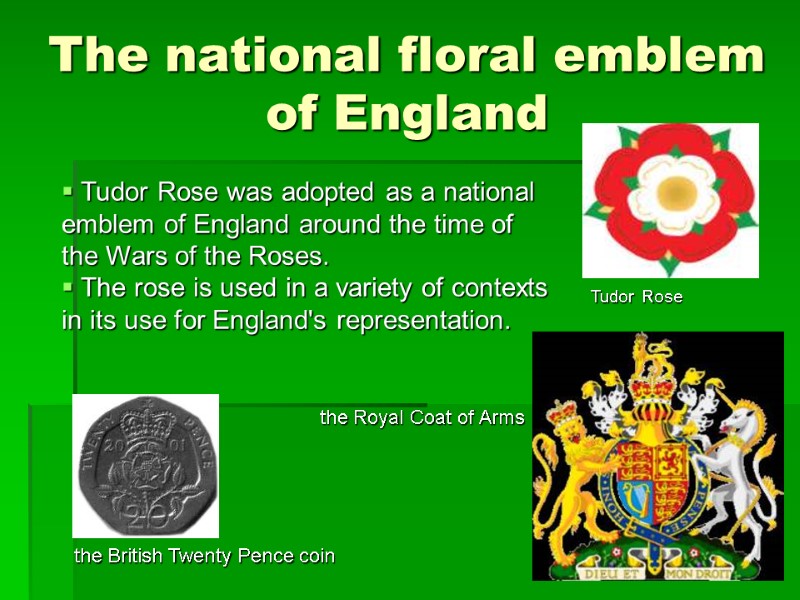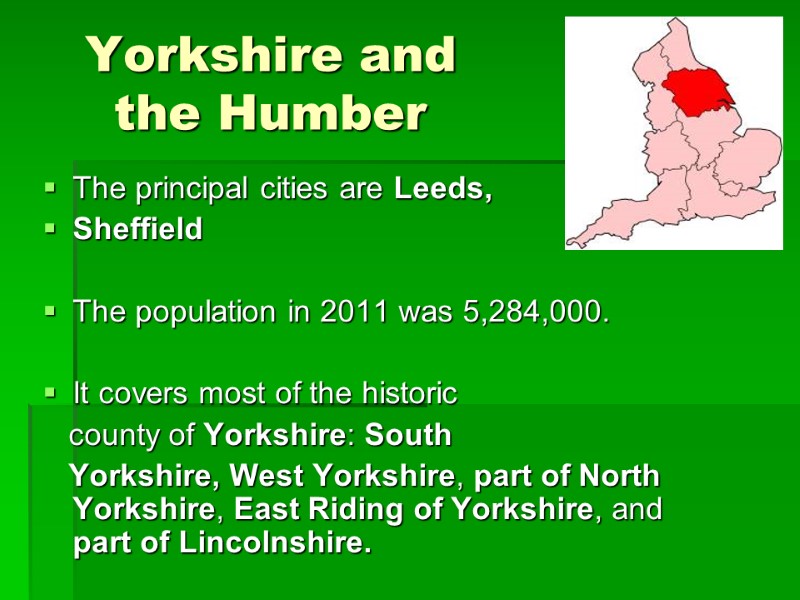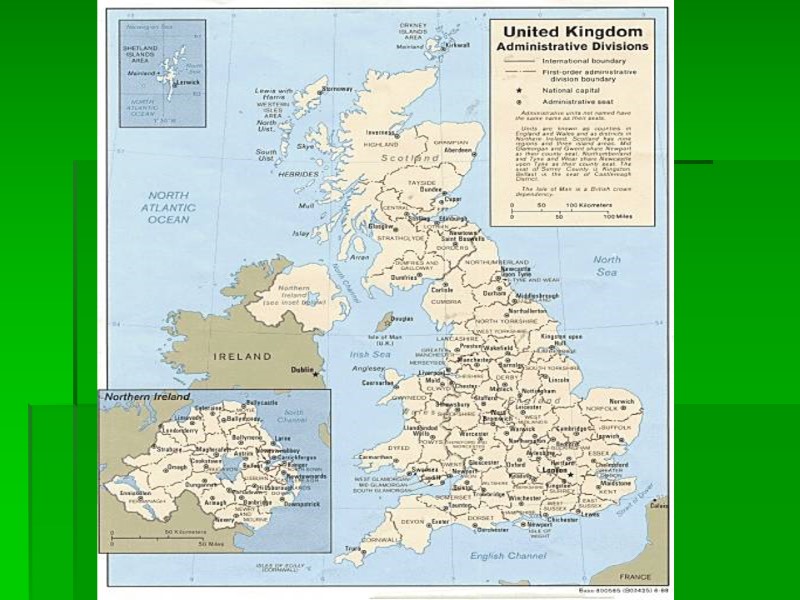POLITICAL SYSTEM OF GREAT BRITAIN Union Jack British


POLITICAL SYSTEM OF GREAT BRITAIN

Union Jack British national flag is called "Union Jack". It symbolises the Union of England, Scotland and Ireland and dates back from 1801. The flag is made up of the crosses of the patron saints of: England (St George's red cross on a white field) Ireland (St Patrick's red diagonals on a white field) Scotland (St Andrew's white diagonals on a blue field) Wales is not represented because when the flag first appeared it was already united with England.


ENGLAND Is the largest and most populous constituent country of the United Kingdom of Great Britain and Northern Ireland. 85% of the total population of the United Kingdom live there. Population: 2006 - est.: 50,690,000 (2001 – census: 49,138,831) Area: 130,395 km² ; ;

England became a unified state during the 10th century and takes its name from the Angles — one of a Germanic tribes who settled in the territory during the 5th and 6th centuries. The capital city of England is London, which is the largest city in the British Isles and largest city in the European Union. It was the birthplace of the Industrial Revolution and was the first country in the world to become industrialised. ENGLAND 2

England is home to the Royal Society, which laid the foundations of modern experimental science. England was the world's first parliamentary democracy. The Kingdom of England was a separate state until 1 May 1707, when the Acts of Union resulted in a political union with the Kingdom of Scotland to create the Kingdom of Great Britain. ENGLAND 3


The national floral emblem of England Tudor Rose was adopted as a national emblem of England around the time of the Wars of the Roses. The rose is used in a variety of contexts in its use for England's representation. Tudor Rose the British Twenty Pence coin the Royal Coat of Arms

Structure of administrative divisions of England

North East North West Yorkshire and the Humber West Midlands (region) East Midlands East of England Greater London South East South West 9 regions in England

Greater London The administrative area was created in 1965 and covers the City of London and 32 London boroughs. In 2016 there was population of 8,70 million people. It covers 1579 km²

North-East England The principal city is Newcastle. Population: 2,597,000 (2011) Consists of the combined area of Northumberland, County Durham, Tyne and Wear and a small part of North Yorkshire.

Yorkshire and the Humber The principal cities are Leeds, Sheffield The population in 2011 was 5,284,000. It covers most of the historic county of Yorkshire: South Yorkshire, West Yorkshire, part of North Yorkshire, East Riding of Yorkshire, and part of Lincolnshire.

North West England The principal cities are Liverpool, Manchester The north of the region (that is, north Lancashire and Cumbria) is largely rural. It has a population of 6,729,764. Consists of the combined area of: Cheshire, Cumbria, Greater Manchester, Lancashire, Merseyside. Rural – venkovský, selský;

The West Midlands The principal city is Birmingham. Population: 2,808,356 (2014) It covers the predominantly rural shire counties of Herefordshire, Shropshire, Staffordshire, Warwickshire, West Midlands, and Worcestershire.

The East Midlands The principal city is Nottingham Population: 4,172,179 (2001) It consists of the combined area of Derbyshire, Leicestershire, Rutland, Northamptonshire, Nottinghamshire and most of Lincolnshire.

The East of England The principal city is Cambridge. Its population as of the 2012 census was 5,907,300. It includes Essex, Hertfordshire, Bedfordshire, Cambridgeshire, Peterborough, Norfolk and Suffolk.

South East England The principal city is Guildford. Its population as of the 2001 census was 8,000,550 - the most populous English region. It includes Berkshire, Buckinghamshire, East Sussex, Hampshire, Isle of Wight, Kent, Oxfordshire, Surrey and West Sussex.

South West England It is the largest region in terms of area. The principal cities are Bristol, Plymouth Population: 4,928,458 people. It includes Somerset, Bristol, Gloucestershire, Wiltshire, Dorset, Devon, and Cornwall.


The Constitution unwritten, based on traditions and common law it´s easy to change it (by an Act of Parliament or by general agreement) divides power between 3 independent branches: 1. legislative 2. executive 3. judicial

1. The LEGISLATIVE power: Parliament comprises 3 parts: the crown, the House of Lords, and the House of Commons makes laws, votes taxes and public expenses checks the work of the Government (the Sovereign, the House of Commons, the House of Lords)

The Houses of Parliament

The Government THE SOVEREIGN at present Queen Elizabeth II. mainly symbolical function (she takes part at ceremonials, traditional celebrations,..) she appoints ministers, judges and governors she is the head of the Armed Forces and of the Church of England THE HOUSE OF LORDS has 810 members the head is the Lord Chancellor made up of the Lords of Temporal (about 900), the Lords Spiritual (2 Archbishops of Canterbury and York + 24 bishops of the Church of England) they sign the bills to consider it as a law, they can refuse bills got from The House of Commons THE HOUSE OF COMMONS consists of 650 Members of Parliament (MPs) – each represents a particular part of the country they pass the bills the Speaker (elected by MPs) = the chief officer - he presides over the house elections – every 5 years minimum voting age – 18 years candidates must be over 21

Benches in the House of Commons Chamber are coloured green. In contrast, the House of Lords is decorated in red.

2. The EXECUTIVE power: THE GOVERNMENT the head is Prime Minister (the leader of the party, which has the majority in The House of Commons) Present PM is Theresa May– leader of the Conservative Party, was appointed by the Queen on 13 July 2016 she chooses her government ministers (about 20) = the Cabinet (formally appointed by the Queen) the second strongest party forms an Opposition (Shadow-Cabinet) the Prime Minister with the Cabinet have real political power

3. The JUDICIAL power: THE SUPREME COURT(consist of 12 justices including the court president and deputy president) consists of the Court of Appeal and the High Court of Justice The independence of the judiciary has never been questioned as a principle, although application is problematic. Personnel have been increasingly isolated from the other organs of government, no longer sitting in the House of Lords or in the Cabinet. The court's ability to legislate through precedent, its inability to question validly enacted law through legislative supremacy and parliamentary sovereignty, and the role of the Europe-wide institutions to legislate, execute and judge on matters also define the boundaries of the UK system.

Political parties in the UK today: The Labour Party - left wing, their program includes many social reforms and active social politics The Conservative Party – right wing, they put more emphasis in private enterprise The Liberals Social and Liberal Democrats - left of centre Scottish National Party (SNP) Sinn Féin - the oldest political movement in Ireland Co-operative Party Democratic Unionist Party Green party Plaid Cymru UK Independence Party Ulster Unionist Party

Thank you for attention! Have a nice day!
10716-the_uk.ppt
- Количество слайдов: 29

